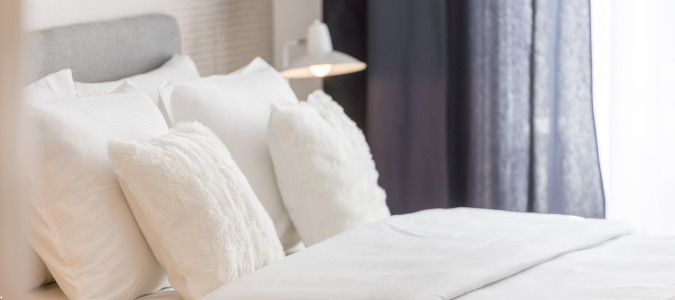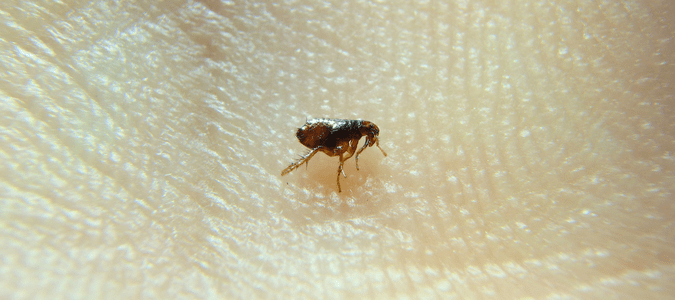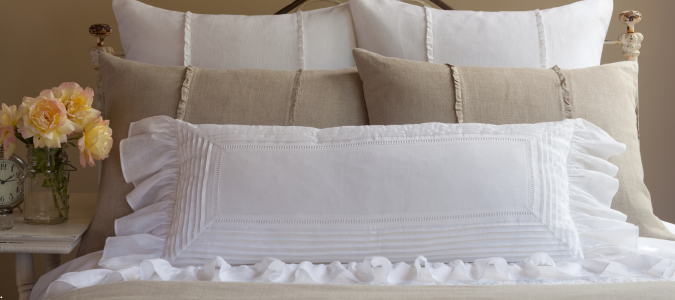Are you worried about fleas around your bed? These pests feed on animal and human hosts. If there’s a flea infestation in your bedroom, you and your pets may wake up with itchy bites.
The first step to controlling fleas around your bed is to look out for the common signs of a flea infestation. Fleas are difficult to spot, but they leave behind several tell-tale signs of their presence.
There are also steps you can take to make your home less hospitable to fleas and keep fleas off you while you sleep. However, the only way to completely control flea bites is to work with a pest control professional.
Signs of Fleas in Your Bed and What to Do Next
Fleas are very small pests that are difficult to spot. A better way to identify a flea infestation is to look for the signs of fleas. Fortunately, fleas leave plenty of signs behind, so staying vigilant can help you catch an infestation early.
Your bed is one of the most unsettling places to find a flea infestation. These pests multiply rapidly and can easily make their way into your bedding if your pet sleeps on the bed with you. The most common signs of fleas in your bed are:
- Flea bites
- Flea dirt
- Flea eggs
- Adult flea sightings
Let’s dive into each of these.
Flea Bites
Spotting flea bites on yourself or a loved one is likely the first sign of fleas in your bed that you will notice. If a pet sleeps in your bed, flea bites may also appear on their skin.
What do flea bites look like? Fleas bite in clusters or straight lines, and the bites look like small red blisters. Flea bites tend to itch and may become irritated and swollen.
It’s important to avoid scratching them. Flea bites should go away on their own; however, if you develop a severe reaction, you should seek medical help.
Where do fleas bite humans? The most common place to find flea bites is on exposed skin, specifically around your ankles, legs, waist and any other area of your skin that comes into contact with your bedding.
Flea Dirt On Your Bedding
Flea feces is often called “flea dirt”. Since fleas consume pet or human blood, flea dirt is made up of digested blood.
When left behind around your bed, flea dirt looks like tiny brown stains. You may see it on your sheets, mattress, comforter or pillowcases.
How can you tell if it’s flea dirt or just regular dirt? Place a few pieces of the dirt on a damp paper towel and see if it changes. If the dirt turns a rusty red color, it is flea dirt.
Flea Eggs Around Your Bed
Flea eggs are even more difficult to spot than fleas, but not impossible. They are tiny, oval-shaped, white eggs that may stand out against your bedding. Fleas often lay flea eggs in seams so they are even more hidden. You may find them around the seams of your mattress, bedding or even in the fibers of the carpet around your bed.
Flea eggs look like tiny grains of sand to the naked eye. If you spot them and aren’t sure whether or not they are flea eggs, it’s best to stay on the safe side and consult with a pest control professional.
Adult Flea Sightings Around Your Bed
While spotting adult fleas is difficult, it can happen. Fleas measure between one-tenth and three-tenths of a centimeter long and are visible to the human eye.
Adult fleas are reddish-brown in color and are known for jumping. Instead of wings, they have powerful hind legs that allow them to leap through the air at long distances.
If you spot any of the above signs of fleas in your home, contact a pest control professional. These pests are hard to control on your own, and an expert will have the right tools and expertise needed to get the job done.
How to Make Your Home Less Hospitable to Fleas
While professional pest control is the best way to get rid of fleas, there are things homeowners can do to make fleas less comfortable in your home. Start by washing all of your bedding in hot water and drying them in hot heat. Include pet bedding in the load as well.
Next, vacuum the whole area, including your mattress, bed frame, the floor around your bed and any upholstered furniture in your bedroom. Throw the vacuum bag away.
If you have pets, treat them with flea medication. You can get flea treatments from your vet, including oral treatments, flea collars and topical solutions. You should also bathe them with a flea shampoo and comb through their fur to remove flea eggs.
Keeping a clean home helps reduce flea hiding spots and goes a long way in preventing the spread of a flea infestation. Regularly mop and vacuum your floors, especially around areas where your pets sleep. However, keep in mind that you can still have a flea problem without pets.
How Do I Keep Fleas Off Me While I Sleep?
How do you prevent fleas from biting you in your sleep? If you have a flea infestation in your bedroom, it’s difficult to completely avoid flea bites. The most important thing is to contact a pest control service to deal with the flea problem.
However, there are a few things you can do to try to limit flea bites. First, wash your bedding regularly. Use hot water and high heat.
Wearing protective clothing in bed can also help. Fleas bite exposed skin, so wearing long sleeves and long pants can reduce their opportunities. That said, they can still bite your hands, face and neck.
Lastly, vacuuming your floor daily can help remove any fleas hiding in your carpet. Fleas regularly lay eggs on carpets to keep them hidden as well.
While these measures may help reduce the flea population in your bedroom, they will not deal with the problem completely. To control a flea infestation, you need to rely on expert help. Call in a local pest control service to take care of the problem.
What Do Flea Eggs Look Like On Bedding?
Flea eggs are small, white and oval-shaped eggs that look like tiny grains of salt. They are very difficult to see with the naked eye, especially on light-colored bedding. These tiny eggs can go unnoticed for a long time; however, if you look closely for them, you may spot them.
To identify flea eggs, inspect your bedding in good light. It can help to shake your bedding out over a dark surface to make the eggs more visible.
Keep in mind that fleas are more attracted to pets than humans. If you have pets in your home, inspect their bedding for fleas and flea eggs. If your pets sleep in your bed, you’ll need to inspect your own bedding as well.
You can still find flea eggs in your bed even if you don’t have pets. When their preferred animal host isn’t available, fleas will feed on humans.
Flea eggs are commonly found in folds of fabric or seams along your mattress. You may also spot them in the fibers of your bedroom carpet. No matter where you find flea eggs, it’s important to act quickly. Flea eggs are a sign of a bigger flea infestation, and professional help is necessary to take care of the entire problem.
Do not hesitate to contact a local pest control professional to deal with the flea infestation.
Kick Fleas Out of Your Bedroom
Whether fleas are infesting your bedding or your pet’s bedding, they are unwanted guests that you should control as soon as possible. To avoid flea bites, contact a pest control specialist to take a look at your flea problem.
You should also take proactive steps to reduce fleas on your own. Washing your bedding, vacuuming your floors and keeping your space clean can go a long way in flea prevention.
When you pair prevention methods with expert treatments, you can reclaim your bedroom from fleas and sleep peacefully again.
ABC Can Solve Your Flea Problems
Keeping fleas at bay takes a lot of time, effort and knowledge. The most effective way to manage a flea infestation is to call in a professional. The pest control pros at ABC Home & Commercial Services can control fleas by treating your home and your yard. We have been controlling fleas for decades, and can inspect your home for signs of a potential infestation. With ABC’s help, you won’t have to worry about flea problems or any other unwanted invaders.



